About 40-80% of people complain that the spine hurts in the lumbar region, but no more than 25% of them seek medical help. In fact, such unpleasant sensations can be caused both by relatively harmless reasons and by pathological changes in the spine. Therefore, you should not treat them with contempt.

Causes of back pain
The spine consists of a whole complex of structural elements: bones, joints, intervertebral discs, ligaments, nerves. Changes in any of them may be accompanied by painful sensations of a different nature. In addition, the spine is surrounded by paraspinal muscles, pain in which patients often confuse with pain in the spine. Thus, the causes of pain can be many. This can be overwork, physical restructuring of the body during pregnancy, etc. But if the pain occurs regularly, it is worth contacting a vertebrate or neurologist, as often the fact that the spine is systemically sore in the lumbar region indicates the development of certain diseases.
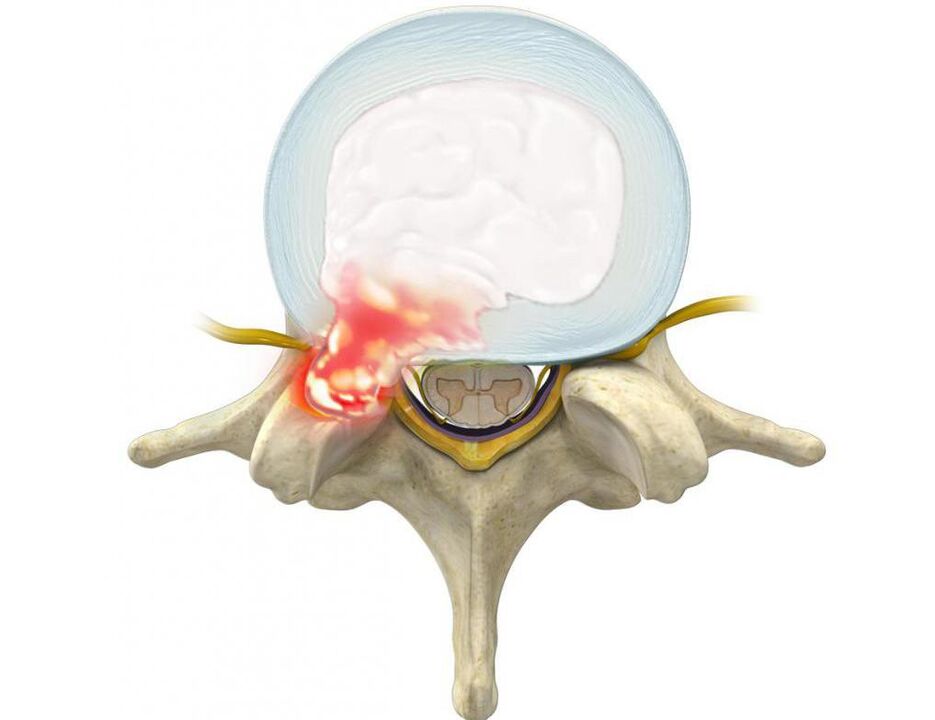
Most often, in such cases, patients are diagnosed with:
- pathology of the intervertebral discs (reduced disc height, protrusion, intervertebral hernia, discitis).
- fold joint pathologies (vertebral joints, joint cysts).
- Inflammatory diseases (ankylosing spondylitis or ankylosing spondylitis, reactive arthritis, psoriatic arthritis)
- compression fractures of the vertebrae on the background of osteoporosis.
- neoplastic lesions of the spine.
Intervertebral disc pathologies
Degenerative changes in the intervertebral discs or osteochondrosis are very common, especially among young and middle-aged people. This is largely due to the need to sit for a long time or do heavy physical work. In old age, the disc dries and the vertebrae grow together.
Already in the early stages of the onset of degenerative changes in the intervertebral discs, which are specially shaped cartilages that separate the vertebral bodies, pain in the spine can occur. This is due to irritation of the pain receptors of the outer layers of the disc, as well as the posterior longitudinal ligament of the spine. Osteochondrosis often causes a sterile inflammatory process, which leads to reflex spasm of the segmental muscles. As a result, the pain in the spine increases, and there are restrictions on mobility.
Osteochondrosis tends to develop constantly, especially in the absence of proper treatment and lifestyle correction. It then leads to the formation of protrusions and later to intervertebral hernias, which causes the worsening of existing symptoms and the appearance of new ones.
The lumbar region, due to the fact that it carries the heaviest loads in daily activities, is affected more often.
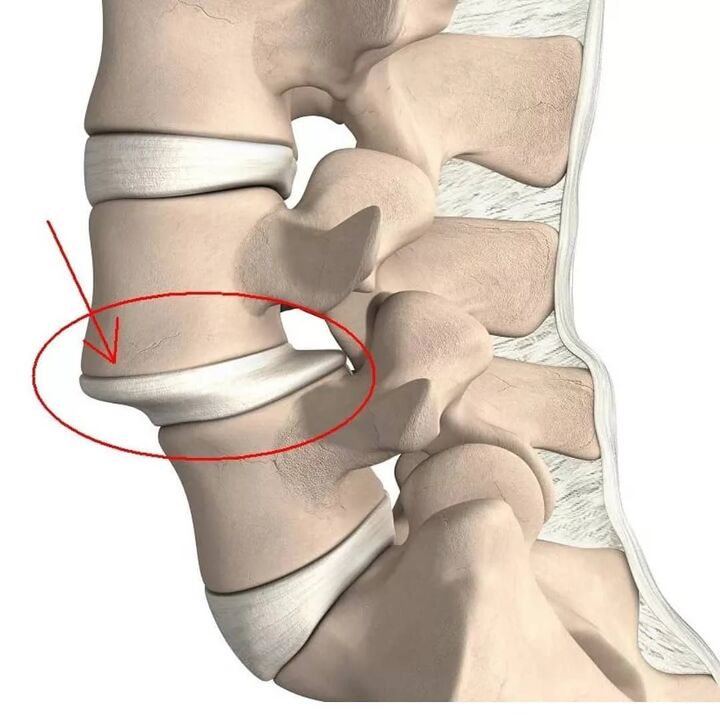
The protrusions are protrusions of the disc while maintaining the integrity of the outside of the shell, called the fibrous ring. While maintaining the effect of the provocative factors over time, the fibers of the fibrous ring do not withstand the load and pressure of the inner contents of the disc (nucleus pulposus) and rupture. As a result, the nucleus exceeds the normal position of the intervertebral disc. At the same time, the spine in the lumbar region always hurts or the pain radiates to the leg and the discomfort increases with sudden movements, bending, lifting heavy objects, strain, coughing, sneezing, laughing, as well as with prolonged sitting. a position, walking, standing.
Often, patients with already formed protrusions and hernias subconsciously take a forced stop, leaning slightly toward the healthy side. In this case, the pain in the spine in the lumbar region can reach high intensity, depriving a person of the ability to work. In such cases, he is forced to rest in bed and to relieve the pain, he tightens the leg that bends and brings it to the stomach.
Most often, protrusions and hernias form in the direction of the spinal canal, through which the spinal cord (cauda equina) passes and the nerve roots that branch from it. The latter pass through the natural openings in the vertebral bodies and branch further into the lumbar plexus, which is responsible for innervating the lower extremities and various organs (including the genitals).
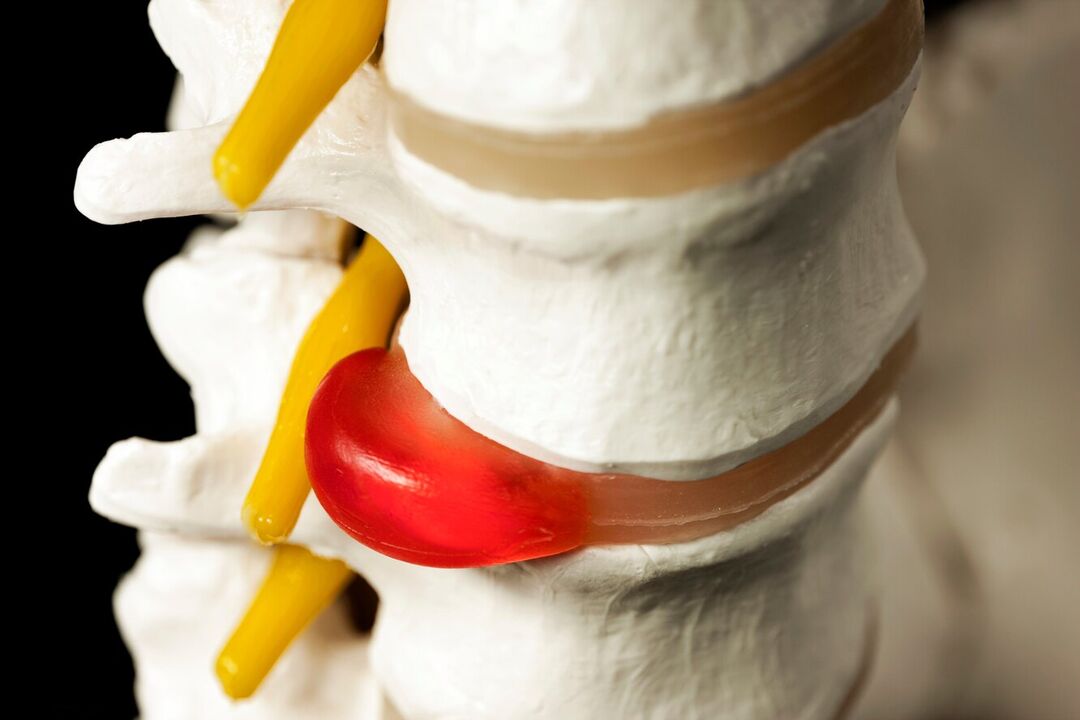
Therefore, often with long-term osteochondrosis, the formation of a hernia in the lumbar region, the pain in the spine is gradually not only intensified, but also complemented by other disorders. If a deformed disc or soft tissue that swells as a result of the inflammatory process presses on the spinal cord that passes near them, neurological disorders occur. Therefore, pain in the spine in the lumbar region can be complemented by radiation to the buttocks, groin, front, inside, outside of the thigh, lower leg and foot. It depends on the type of nerve root that will be affected, ie at the level of the movement part of the spine pathological changes will be observed. Also, in the corresponding areas of the lower extremities, sensitivity disorders can be observed in the form of a feeling of cramping, numbness, changes in temperature sensitivity, pain, tactile stimuli and limited mobility.
Changes in the height and function of the discs that occur in osteochondrosis and its complications lead to damage to the articular apparatus of the spine, as well as degeneration of the vertebral bodies themselves. The consequence of this is the development of vertebrae, ie calcification of the anterior longitudinal ligament and the formation of bone-coarse growths on the surface of the vertebral bodies (osteophytes). They can not only injure the surrounding tissue and press on the roots of the spine, causing severe pain in the spine, but also grow together. As a result, the adjacent vertebral bodies are combined into a single whole, which sharply reduces mobility in the lower back.
Osteochondrosis may be accompanied by reactive changes in the vertebral bodies, in particular, reactive aseptic spondylitis, leading to osteosclerosis. This is accompanied by compression of the bone tissue and dramatically increases the chance of vertebral fractures.
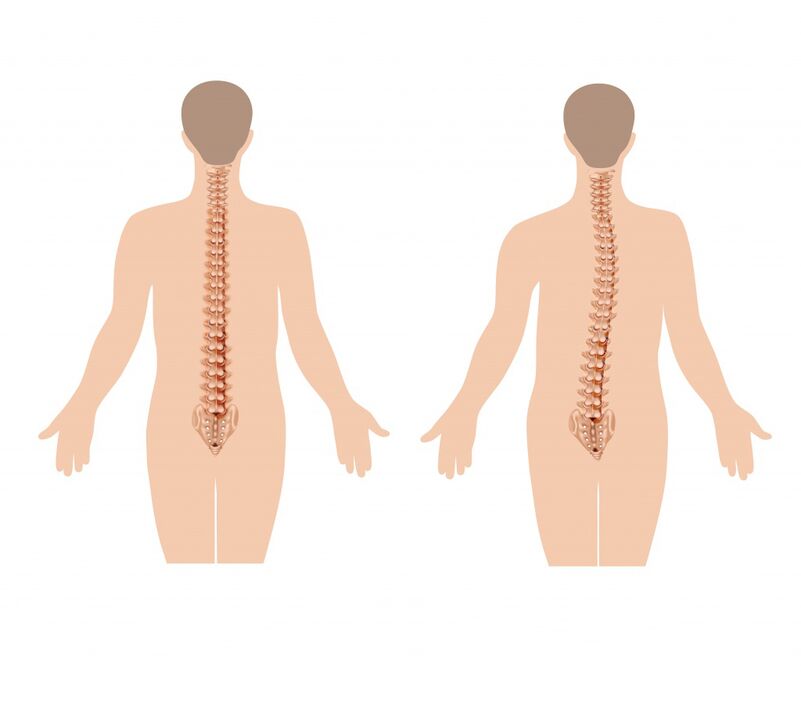
Diseases of the facial joints
Pathologies of the face or lumbar joints of the spine, especially their arthropathy, can also cause pain in the spine in the lumbar region, including severe pain. Although more often the pain hurts and is located deep inside. Their appearance is due to the fact that their joint capsule is richly ribbed. In such situations, the pain usually accumulates directly in the affected area and tends to increase with flexion, extension, rotation of the body, prolonged standing. Walking and sitting help to reduce their severity. But in some cases, pain can also be given in the groin, coccyx, as well as in the back and outside of the thighs.
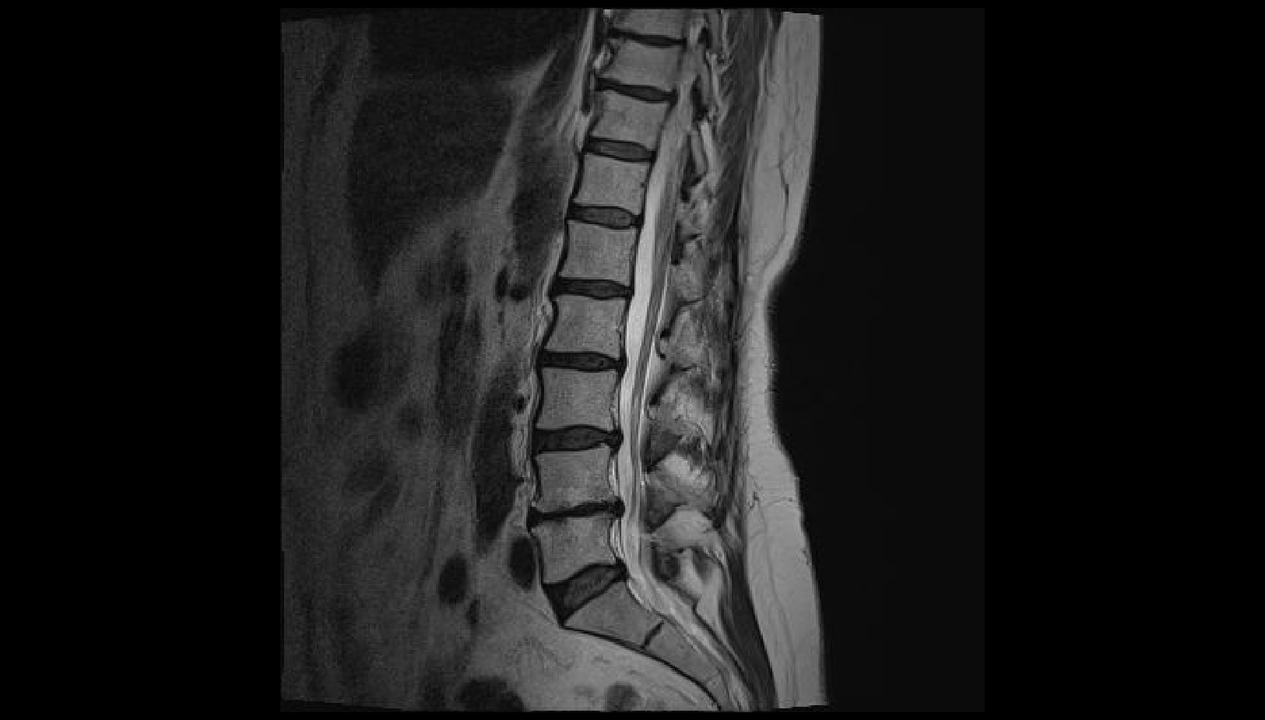
Inflammatory diseases of the spine
Inflammatory diseases of the spine are less common than pathologies of the intervertebral discs and joints of the face. But they also hurt the spine. These include:
- ankylosing spondylitis or ankylosing spondylitis.
- reactive arthritis;
- psoriatic arthritis etc.
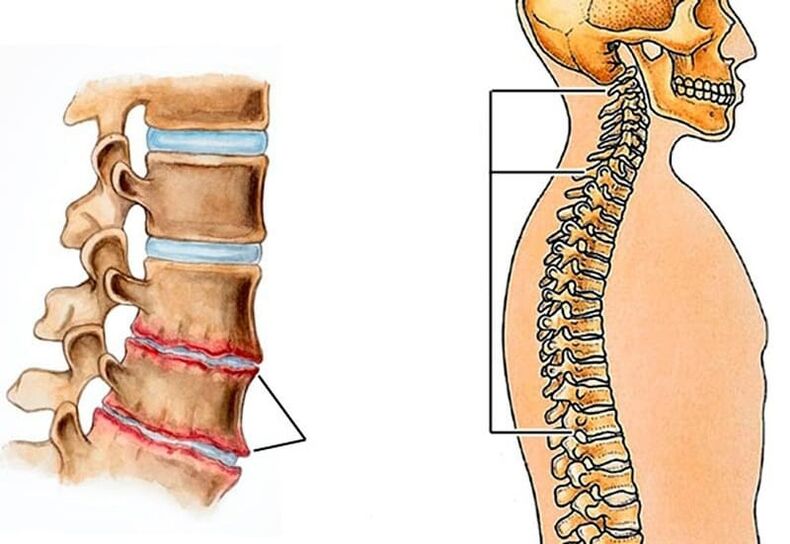
The symptoms of these diseases usually appear before the age of 40 and most often at the age of 20. This distinguishes them from the degenerative-dystrophic pathologies of the discs and joints of the spine, which often develop after 40 years. In this case, the pain is characterized by a gradual increase in intensity. In addition, their severity decreases after exercise, but does not decrease at rest. Therefore, in inflammatory diseases, the spine in the lumbar region often hurts at night and especially intensely in the morning, immediately after sleep.
The most difficult condition is observed with ankylosing spondylitis and is the one that most often than other inflammatory diseases affects the lumbar region. This term means inflammation of the intervertebral joints with their subsequent immobilization due to the formation of dense bone, cartilage or fibrous fusion between the articular bone structures.
It is initially characterized by mild back pain, but over time it gradually spreads higher, covering the thoracic and then the cervical spine. This is associated with the development of limited mobility of the spine at all levels, since the spine, as a result of the changes that take place, appears to be submerged in a particular case. It was also observed:
- alignment of the lumbar lordosis (natural curvature of the spine in the lumbar region).
- worsening of thoracic kyphosis, which causes crouching.
- reflex tension of the back muscles.
- progressive deterioration of the restriction of mobility due to the involvement of the facial joints in the pathological process and the ossification of the intervertebral discs.
- morning stiffness for an hour or more.
In 10-50% of patients, inflammation of the iris (iritis), cornea (keratitis), mucosa (conjunctivitis), iris and eyelid of the eyeball (iridocyclitis) is observed.
The development of ankylosing spondylitis leads to the fact that an increasing number of joints in the pathological process. As a result, patients are forced to acquire the so-called pleading attitude. It means intense kyphosis of the thoracic spine, inclination of the upper body downwards, bending of the knees with a sharp restriction of the range of motion in the chest, which affects the depth of breathing.
The rate of disease progression depends on the adequacy and completeness of treatment.
Compressive vertebral fracture
The compression fracture is the flattening of the vertebral body, resulting in a wedge-shaped shape. This leads to a disorder of the anatomy of the spine, can cause trauma to the spinal cord and its roots and also become an activating factor for the rapid development of degenerative-dystrophic changes.
Lumbar vertebrae 1 and 2 are more prone to injury, as they take on the greatest axial load.
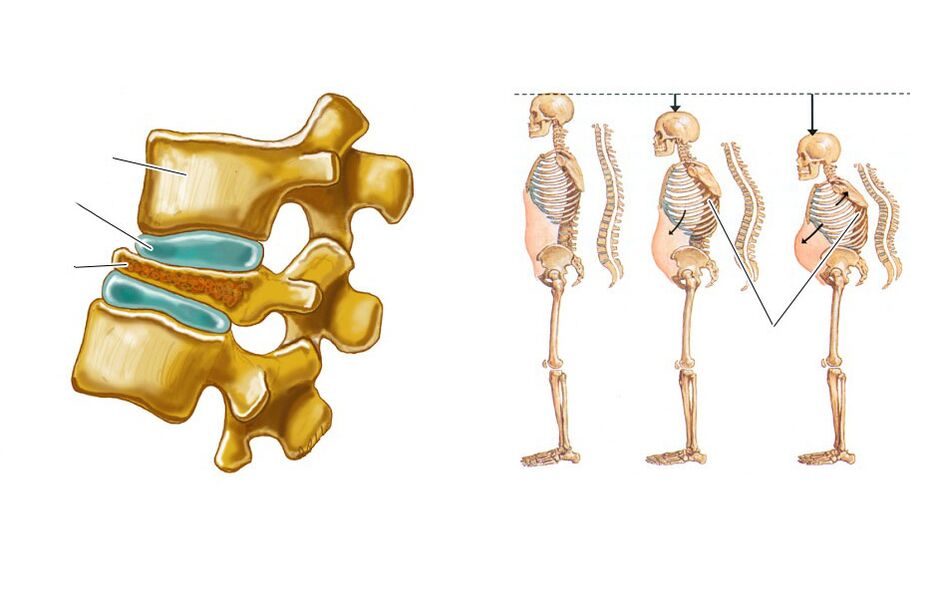
Compression fractures of the spine often occur in the elderly due to the development of osteoporosis, ie a decrease in bone density. In such cases, not only a slight fall, but also lifting weights, an unsuccessful move, may be enough to injure yourself.
The pathology is characterized by the presence of pain in the spine, which restricts movement, increases with sitting, movement and tries to lift a straight leg up. It usually lasts 1-2 weeks and then gradually decreases to 2-3 months. In some cases, there is radiation pain in the tops of the pelvic bones and hips. Reducing the height of a broken vertebra causes an increase in lumbar lordosis, which also contributes to the appearance of painful sensations.
If a fracture is not diagnosed in time, the reduction in the height of the vertebrae leads to changes in posture, reduced growth. This causes reflex tension and shortening of the muscles of the spine, which causes chronic back pain and requires long-term rest.
Neoplastic lesions of the spine
Neoplastic lesions of the spine mean the formation of benign and malignant tumors in it, as well as metastases, the source of which are neoplasms of other organs. This is much less common than pathologies of the intervertebral discs, joints of the face, ankylosing spondylitis, and even compression fractures, specifically in only 1-2% of patients with back pain. But such lesions require early diagnosis and treatment.

The features of neoplastic lesions of the spine, in addition to pain in it, are:
- increase in body temperature, including febrile values.
- unjustified weight loss;
- inability to find a comfortable body position.
- the presence of pain at night.
- severe pain in the spine.
- inability to relieve pain with conventional analgesics.
Even if you have 1 or 2 of these symptoms, you should make an appointment with your doctor immediately.
In a similar way, the following may appear:
- Chondroma is a malignant tumor that is diagnosed in 20% of patients with spinal cancer. It most often forms in the sacrum and can occur in people of any age and gender.
- Young sarcoma - occurs in 8% of patients with neoplastic lesions of the spine. More common in young men.
- Chondrosarcoma is a malignant neoplasm, which accounts for 7-12% of cases. It is more commonly found in middle-aged men.
- An aneurysmal bone cyst is a benign tumor.
- Hemangioma is a benign vascular tumor that occurs in 11% of people. It may not be detected throughout a person's life. But it increases the risk of vertebral fractures.
- Metastases of other tumors are secondary malignancies. Most often, cancers of the breast, prostate, lungs and, less commonly, the kidneys, thyroid gland and skin metastasize to the spine.
Diagnostics
If the spine hurts in the lumbar region, it is worth making an appointment with a neurologist or spine specialist. At the appointment, the doctor first collects a history, asking questions about the nature of the pain, the conditions of its appearance, the duration of its persistence, the presence of other symptoms, the way of life, etc.
The specialist then conducts an examination. In this context, it not only palpates the spine, determines the location of pain, evaluates the patient's gait and posture unconsciously, but also performs functional examinations. With their help, you can detect signs of ankylosing spondylitis, neurological deficit, assess the degree of mobility of the spine and receive other diagnostic data.
Based on this, the doctor can already guess the possible causes of the pain syndrome. In order to clarify them, as well as to accurately determine the degree of damage, additional diagnostic methods of instruments and sometimes laboratory are prescribed. Most of the time they seek help:
- X-ray in frontal and lateral view, sometimes with functional radiological examinations.
- Computed tomography - allows better imaging of bone structures, therefore, is more often used to diagnose vertebrae, fractures, bone tumors, etc.
- MRI - makes it possible to assess the condition of cartilaginous structures and soft tissues as meticulously as possible, so it is often used to diagnose osteochondrosis, protrusions, intervertebral hernias, spinal cord lesions, etc.
- Electromyography - indicated for neurological disorders of unknown origin, as well as for the assessment of the degree of nerve damage.
- Radioisotope bone scintigraphy - used to diagnose malignancies and metastases.
- X-ray densitometry is the best method for diagnosing osteoporosis.
- myelography - used to detect points of compression of the spinal cord and equine tail nerves.

Treatment
For each patient, the treatment is chosen strictly on an individual basis, and not only based on the diagnosis, but also the nature of the existing concomitant pathologies. However, it is the cause of back pain that determines the tactics of treatment. It may be conservative or may involve surgery.
But the first step is always to direct the efforts to relieve the pain, especially if possible. For this, patients are prescribed NSAIDs, anticonvulsants, analgesics. And in severe cases there are blockages of the spine - injections of anesthetics and corticosteroids in specific areas of the spine.
Bed rest does not occur in all patients. And with pathologies of the intervertebral discs, it may be completely contraindicated, as the reduction of physical activity contributes to the conversion of acute pain in the spine into a chronic one.
Exclusively conservative or non-surgical treatment is prescribed for:
- osteochondrosis;
- ankylosing spondylitis?
- joints of the facial joints.
- slight compressive fractures.
It is usually complex and consists of:
- drug therapy, which may include NSAIDs, chondroprotectants, muscle relaxants, immunosuppressants, corticosteroids,
- physiotherapy (UHF, magnetotherapy, laser therapy, traction therapy, etc. ).
- Exercise therapy?
- manual therapy.

If the cause of back pain is intervertebral hernias, protrusions, vertebrae, severe vertebral fractures, tumors, surgery is often indicated. It is also necessary for:
- ineffectiveness of conservative treatment for degenerative-dystrophic changes.
- increase in neurological deficit;
- instability of the movement part of the spine.
- the development of complications, in particular narrowing of the spinal canal.
Most modern spine surgeries are minimally invasive. Thanks to this, the intraoperative and postoperative risks are sharply reduced, the recovery period is shortened and facilitated and the efficiency is not less than more traumatic open surgeries. Depending on the disease being detected, it may be recommended:
- Discectomy is a procedure that is mainly indicated for hernias and protrusions, especially those that cause equine tail syndrome. It can be performed using microsurgical instruments through an incision of 3 cm (microdiscectomy) and using endoscopic equipment provided to the spine through punctures with a diameter of about 1 cm (endoscopic discectomy). When the intervertebral disc is completely removed, it is usually replaced with implants.
- Vertebroplasty and kyphoplasty - suitable for compression fractures of the vertebrae, hemangiomas and some other diseases. The essence of the operation is the injection of bone cement rapidly hardening through a thin tube into the vertebral body, which strengthens it. With kyphoplasty it is also possible to restore the normal dimensions of the vertebral body, which is important in case of severe reduction in height as a result of a fracture.
- Fixation surgeries are used to stabilize the spine. For this, metal constructions of different nature are used, which usually remain in the patient's body until the end of his life.
Thus, the spine in the lumbar region can ache for various reasons. Therefore, with prolonged persistence of painful sensations, their regular appearance, increased pain over time and even more the addition of other symptoms, it is imperative to contact a vertebrate or neurologist. Early diagnosis will allow the detection of pathological changes in the stages that are easier to treat and if the disease is not completely cured, then at least stop its progression and maintain a high standard of living.












































